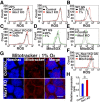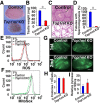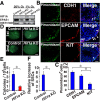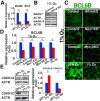An interplay of NOX1-derived ROS and oxygen determines the spermatogonial stem cell self-renewal efficiency under hypoxia
- PMID: 33446567
- PMCID: PMC7849365
- DOI: 10.1101/gad.339903.120
An interplay of NOX1-derived ROS and oxygen determines the spermatogonial stem cell self-renewal efficiency under hypoxia
Abstract
Reactive oxygen species (ROS) produced by NADPH1 oxidase 1 (NOX1) are thought to drive spermatogonial stem cell (SSC) self-renewal through feed-forward production of ROS by the ROS-BCL6B-NOX1 pathway. Here we report the critical role of oxygen on ROS-induced self-renewal. Cultured SSCs proliferated poorly and lacked BCL6B expression under hypoxia despite increase in mitochondria-derived ROS. Due to lack of ROS amplification under hypoxia, NOX1-derived ROS were significantly reduced, and Nox1-deficient SSCs proliferated poorly under hypoxia but normally under normoxia. NOX1-derived ROS also influenced hypoxic response in vivo because Nox1-deficient undifferentiated spermatogonia showed significantly reduced expression of HIF1A, a master transcription factor for hypoxic response. Hypoxia-induced poor proliferation occurred despite activation of MYC and suppression of CDKN1A by HIF1A, whose deficiency exacerbated self-renewal efficiency. Impaired proliferation of Nox1- or Hif1a-deficient SSCs under hypoxia was rescued by Cdkn1a depletion. Consistent with these observations, Cdkn1a-deficient SSCs proliferated actively only under hypoxia but not under normoxia. On the other hand, chemical suppression of mitochondria-derived ROS or Top1mt mitochondria-specific topoisomerase deficiency did not influence SSC fate, suggesting that NOX1-derived ROS play a more important role in SSCs than mitochondria-derived ROS. These results underscore the importance of ROS origin and oxygen tension on SSC self-renewal.
Keywords: Hif1; reactive oxygen species; spermatogonia.
© 2021 Morimoto et al.; Published by Cold Spring Harbor Laboratory Press.
Figures







Similar articles
-
Glutamine protects mouse spermatogonial stem cells against NOX1-derived ROS for sustaining self-renewal division in vitro.Development. 2023 Oct 15;150(20):dev201157. doi: 10.1242/dev.201157. Epub 2023 Mar 30. Development. 2023. PMID: 36897562 Free PMC article.
-
ROS amplification drives mouse spermatogonial stem cell self-renewal.Life Sci Alliance. 2019 Apr 2;2(2):e201900374. doi: 10.26508/lsa.201900374. Print 2019 Apr. Life Sci Alliance. 2019. PMID: 30940732 Free PMC article.
-
ROS are required for mouse spermatogonial stem cell self-renewal.Cell Stem Cell. 2013 Jun 6;12(6):774-86. doi: 10.1016/j.stem.2013.04.001. Cell Stem Cell. 2013. PMID: 23746981
-
Molecular regulation of spermatogonial stem cell renewal and differentiation.Reproduction. 2019 Nov;158(5):R169-R187. doi: 10.1530/REP-18-0476. Reproduction. 2019. PMID: 31247585 Review.
-
Redox signaling (cross-talk) from and to mitochondria involves mitochondrial pores and reactive oxygen species.Biochim Biophys Acta. 2010 Jun-Jul;1797(6-7):897-906. doi: 10.1016/j.bbabio.2010.01.032. Epub 2010 Feb 1. Biochim Biophys Acta. 2010. PMID: 20122895 Review.
Cited by
-
Glutamine protects mouse spermatogonial stem cells against NOX1-derived ROS for sustaining self-renewal division in vitro.Development. 2023 Oct 15;150(20):dev201157. doi: 10.1242/dev.201157. Epub 2023 Mar 30. Development. 2023. PMID: 36897562 Free PMC article.
-
Regulation of male germline transmission patterns by the Trp53-Cdkn1a pathway.Stem Cell Reports. 2022 Sep 13;17(9):1924-1941. doi: 10.1016/j.stemcr.2022.07.007. Epub 2022 Aug 4. Stem Cell Reports. 2022. PMID: 35931081 Free PMC article.
-
New Insights into D-Aspartate Signaling in Testicular Activity.Cells. 2024 Aug 22;13(16):1400. doi: 10.3390/cells13161400. Cells. 2024. PMID: 39195288 Free PMC article. Review.
-
Impact of the hypoxic microenvironment on spermatogonial stem cells in culture.Front Cell Dev Biol. 2024 Jan 18;11:1293068. doi: 10.3389/fcell.2023.1293068. eCollection 2023. Front Cell Dev Biol. 2024. PMID: 38304612 Free PMC article.
-
NADPH oxidases: redox regulation of cell homeostasis and disease.Physiol Rev. 2025 Jul 1;105(3):1291-1428. doi: 10.1152/physrev.00034.2023. Epub 2025 Jan 15. Physiol Rev. 2025. PMID: 39814410 Free PMC article. Review.
References
Publication types
MeSH terms
Substances
LinkOut - more resources
Full Text Sources
Other Literature Sources
Molecular Biology Databases
Research Materials
